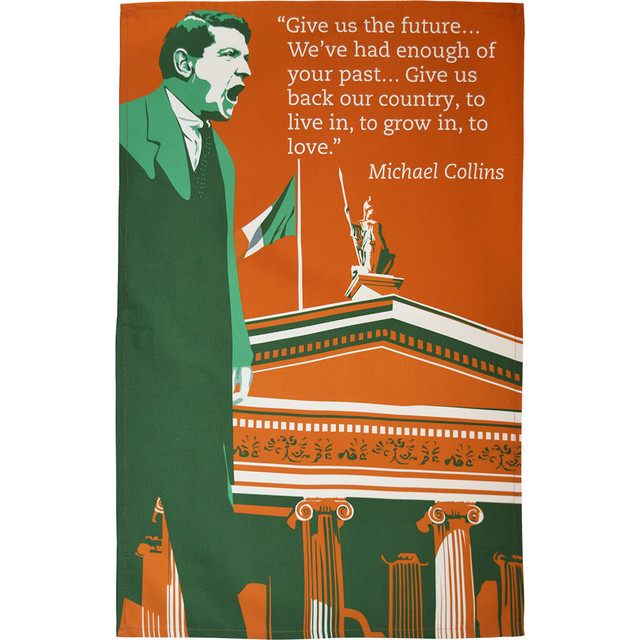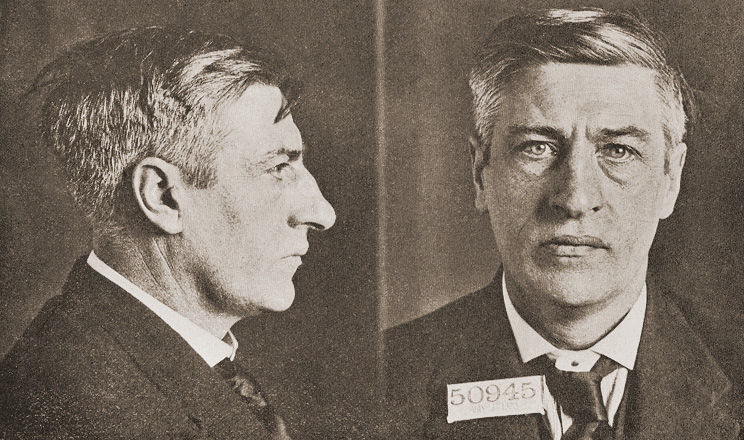Jim Larkin: “The great appear great because we are on our knees: Let us rise.”
Posted by Pete on 28th Jan 2024
Jim Larkin, who has a statue in central Dublin, was a rallying cry for the Irish Left

Jim Larkin's statue outside the General Post Office in Dublin
At the start of the twentieth century, political radicalism in Ireland was about more than just independence from British rule.
In addition to the anticolonial struggle, thousands of trade unionists and socialists were fighting to liberate the Irish working class.
Alongside James Connolly, the outstanding leader of radical workers in Ireland was Jim Larkin, born on this day 150 years ago.

Michael Collins, another early 20th century Irish revolutionary, has recently joined our collection
Browse Irish-themed tea towels
Jim Larkin led a very Atlantic life.
He was born in Liverpool to Irish parents, and first made his name as a labour organiser in England and Scotland.
Larkin then moved his focus to Ireland, but also spent a long time in the USA working with the socialist movement there.
Larkin’s most famous battle was the Dublin Lockout of 1913 – a founding moment of the Irish working class.

The Easter Rising of 1916 was an armed uprising, fuelled by years of frustration experienced by ordinary Irish people
See the Easter Rising tea towel
By the time of the Lockout, Larkin had already been organising workers across Ireland since 1907.
In 1908, he co-founded the Irish Transport and General Workers’ Union (ITGWU) with James Connolly. And in 1912, they helped set up the Irish Labour Party, too.
The Lockout began when ITGWU tram workers in Dublin went on strike for better pay on 26th August.
The response of bosses in Dublin was instant and despotic.
The Dublin United Tramway Company led a coalition of employers to threaten their workers with being sacked if they joined the ITGWU.
But Irish workers didn’t take kindly to being bullied.
Tens of thousands preferred the insecurity and impoverishment of being locked out of work to abandoning working-class solidarity.
In the year-long standoff that followed, Jim Larkin helped to rally the Irish Left.
"My suggestion to the employers is that if they want peace we are prepared to meet them, but if they want war, then war they will have."
But the Dublin bosses had the police and the press on their side – many of the employers also owned major Irish newspapers.
Larkin and his comrades were demonised in the right-wing reaction, and the police regularly and violently assaulted striking workers in Dublin.
To defend workers against police brutality, Larkin and Connolly also co-founded the Irish Citizen Army (ICA) during the Lockout.
But the bosses ultimately prevailed in early 1914.
Running desperately low on funds and supplies, Dublin workers were effectively starved back to work on worse conditions.
Larkin and Connolly conceded defeat when the British Trades Union Congress (TUC) refused to call a strike in solidarity with their fellow workers in Ireland.

It would be years later before the TUC was prepared to call a nationwide General Strike
See the General Strike tea towel
Larkin’s hostility to the British state and British unions only increased during World War I.
With Britain entering a brutal European war, and trying to drag in Ireland, too, a close alliance was formed between the socialist and republican movements.
Jim Larkin was enthusiastic about this anti-imperialist coalition. Having moved to New York in 1914, he immediately began agitating against British rule in Ireland.
“…we shall not fight for England. We shall fight for the destruction of the British Empire and the construction of an Irish Republic.”
Larkin found solid support among the large Irish diaspora in the U.S. From afar, he supported and raised funds for the Irish independence struggle after the Easter Rising of 1916.
Larkin was still in the U.S. when the Bolshevik Revolution happened in 1917.
His support for this new, more radical version of socialism was less well-received in America than his Irish nationalism – especially by the government.
During the so-called First Red Scare of the late 1910s, when the Woodrow Wilson government began locking up progressives such as Emma Goldman and Eugene Debs, Jim Larkin was imprisoned, too.
Larkin was sentenced to several years in prison for so-called “criminal anarchy” due to pro-communist speeches he’d given during 1919.
Once things in the U.S. had cooled down, Larkin was released early in 1923.
He soon returned to Ireland where, during the next two decades, he continued trying to build a left-wing labour movement.

Jim Larkin was jailed for 'criminal anarchy' during the US Red Scare of the 1910s
James Larkin died in January 1947.
He received a massive public funeral in Dublin, overseen by the Archbishop. The ageing veterans of the Irish Citizen Army – who, after the Dublin Lockout, had gone on to fight in the Irish war of independence – provided an honour guard.
Today, there’s a statue of Larkin right in the centre of Dublin. It is inscribed with one of his favourite radical quotes, dating back to the French Revolution:
“The great appear great because we are on our knees: Let us rise.”
